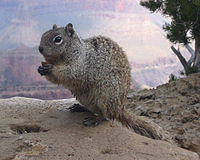- Complex-toothed flying squirrel
-
Complex-toothed flying squirrel
Temporal range: Early Pleistocene to RecentConservation status Scientific classification Kingdom: Animalia Phylum: Chordata Class: Mammalia Order: Rodentia Family: Sciuridae Tribe: Pteromyini Genus: Trogopterus
Heude, 1898Species: T. xanthipes Binomial name Trogopterus xanthipes
(Milne-Edwards, 1876)The complex-toothed flying squirrel (Trogopterus xanthipes) is a flying squirrel found in the southern Chinese provinces Hubei, Hunan, Guizhou, Sichuan and Yunnan. Its name originates from the teeth, which differ from the other flying squirrels. The squirrel looks similar to other flying squirrels, most strikingly is a cluster of black hair at the bottom of the ear. The fur is grey-brown on top and white on bottom. Both its face and its tail are slightly red. The length of the body is about 30 cm, plus the tail which is another 30 cm long. The complex-toothed flying squirrel is an endangered species, both due to the destructions of forests as well as due to hunting.
Trogopterus xanthipes builds its nests in cliffs, usually around 30 m above the ground. They live in mountainous terrain in altitudes of 1300 to 1500 m above sealevel, according to some sources up to 2750 m. They are nocturnal, at night they leave their nests and search for nuts, fruits and branches.
Though five species of the genus Trogopterus had been described, they are now believed to be all of the same sole species T. xanthipes. The closely related hairy-footed flying squirrel (Belomys pearsoni) is sometimes also added to the genus Trogopterus.
In Traditional Chinese medicine the feces of the squirrel, known as the Five Spirits Grease (五靈脂, wǔ líng zhī) are believed to help against ulcer in the duodenum.
References
- ^ Smith, A. T. & Johnston, C. H. (2008). Trogopterus xanthipes. In: IUCN 2008. IUCN Red List of Threatened Species. Downloaded on 8 January 2009.
Categories:- IUCN Red List near threatened species
- Flying squirrels
- Traditional Chinese medicine
Wikimedia Foundation. 2010.




